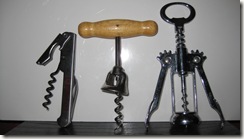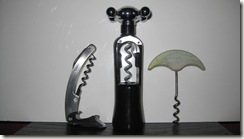![]()

Early wine was stored first in terracotta amphoras and later in wooden barrels. Wine was never aged; it was briefly stored or transported and served before it had a chance to spoil. Wine glasses and decanters first appeared in Venice around the 12th century, used only for serving the wine.
Glass-blowing technology improved and in the early 18th century glass wine bottles with small bottlenecks made airtight wine storage possible. Wine could now be safely aged.
The English were the first to seal wine bottles, using cork imported from Spain or Portugal. Cork comes from the wood of the Quercus Suber or cork tree, a species of Oak native to Spain. Obviously, corkscrews were invented as an easy way of removing the cork from a bottle.
However, wine bottles were not the first bottles to be corked. Bottle tops and cans did not become common until after W.W.II. Before that time and before wine was ever corked, all kinds of substances were often stored in corked containers: beer, medicine, cosmetics and food. Many of these corked items required small corkscrews.
Who invented the first corkscrew? Corkscrew historian Ron McLean from the "The Virtual Corkscrew Museum" had this to say:
"It is unknown when and who made the first corkscrew. The first corkscrews were derived from a gun worme, a tool with a single or double spiral end fitting used to clean musket barrels or to extract an unspent charge from the barrel. By the early 17th century corkscrews for removing corks were made by blacksmiths as using a cork to stopper a bottle was well established."
Corkscrew inventors were inspired by a tool called the bulletscrew or gun worm, a device that extracted stuck bullets from rifles. McLean lists the following corkscrew patents gathered from his research as being firsts in several respective countries.
England: Patent No 2061 granted to Samuel Henshall, Princes Street, Parish of Christchurch, Middlesex, on August 24, 1795. France: Patent No. 3571 granted to Francois Rever on February 23, 1828. U. S. A.: Patent No. 27,615 (see above) granted to M.L. Byrn of New York, N.Y. for a corkscrew on March 27, 1860. However, a much earlier patent No. 15,325 (see below) was granted on July 15, 1856 to George Blanchard of New York, N.Y. for a metallic tube nutmeg grater as the handle of a corkscrew. The patent illustration shows the tubular nutmeg grater as the handle of a wire helix corkscrew with the patent description mentioning the corkscrew connection three times. Germany: Patent No 16 granted to Benjamin Loew of Tilsit on July 3, 1877. Canada: Patent No.16,163 granted to William Addison of Hamilton, Ontario on January 23, 1883.

The patent drawing above illustrates a nutmeg grater and corkscrew combination tool.


